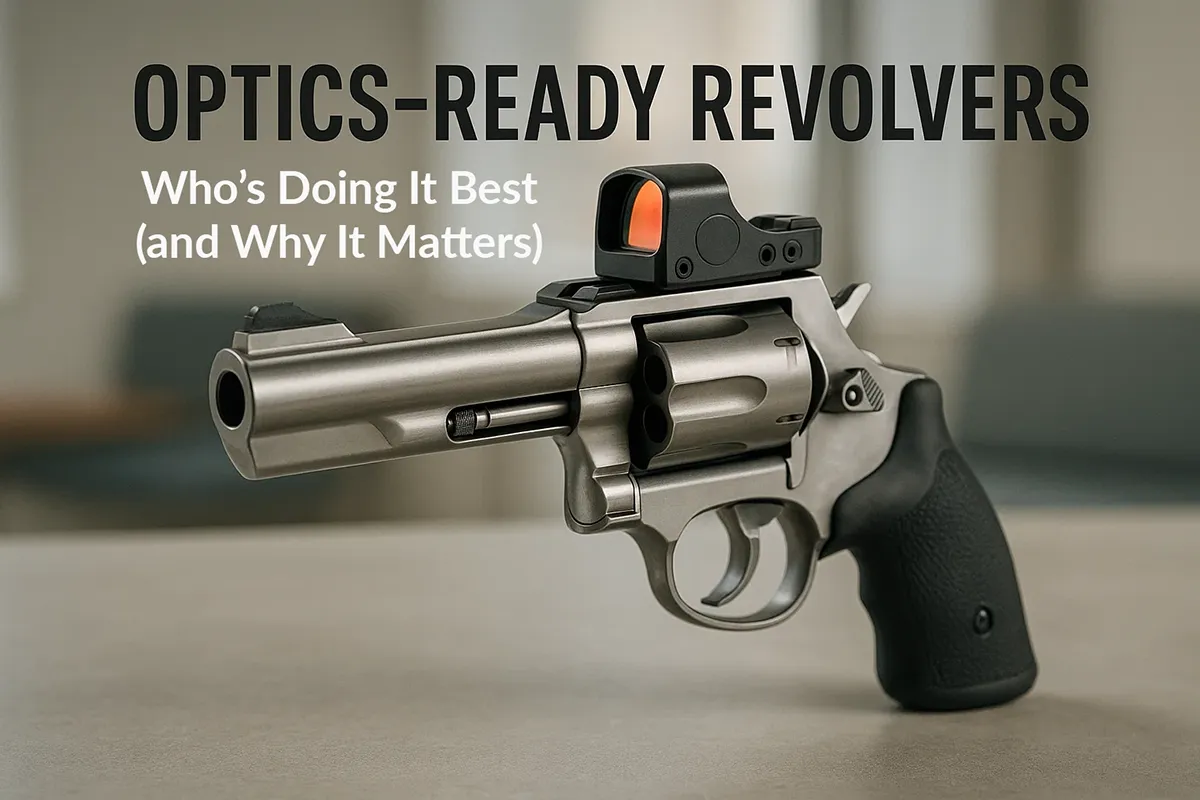Optics-Ready Revolvers in 2025: Who’s Doing It Best (and Why It Matters)
October 14, 2025

Red dots on wheelguns have moved from “niche experiment” to a legit option this fall. If you like revolver simplicity but want faster sighting, today’s optics-ready models and factory-mount solutions make that combo far easier than even a year ago.
Over the last month, we’ve seen a clear uptick in factory-threaded sight cuts, drilled-and-tapped topstraps, and brand-made mounting plates that let a modern micro red dot live happily on a six- or seven-shooter. It’s not replacing irons overnight, but for hunters, defensive shooters, and competition dabblers, the “dot on a wheelgun” conversation is now very real—especially as deer seasons kick off and low-light shots highlight the benefit of a crisp, single focal plane. (Also: yes, your grandpa’s wheelgun just got a heads-up display—he’ll survive.)
The Trend
- Factory optics provisions are showing up across price tiers. Instead of third-party rails or gunsmith cuts, more revolvers now arrive with a plate system or direct-mount solution. That shortens the path from box to range and keeps tolerances tighter.
- Dots are improving practical accuracy for more shooters. Many people shoot revolvers double-action; a red dot helps track the front end through the stroke and speeds up follow-ups, especially with .357 Magnum and .44 spl/low-recoil loads.
- Hunting and “kit gun” roles lead adoption. Woods carry and small-game setups see big gains from precise holds at irregular distances. As suppressor-ready rimfire and .38 Special woods guns trend, a dot makes small targets less… small.
Spec Highlights & Standouts
- Medium-frame .357s with seven rounds are increasingly common in optics-ready trims—more capacity without a giant frame.
- DAO “fighting revolver” builds pair a tuned pull with a low-mounted micro reflex sight, giving you snag-free carry and faster sight pictures.
- Purpose-built plates and screws beat generic rails: better screw length, correct thread pitch, and plate footprints matched to popular dots reduce zero-shift headaches.
Comparisons
Below are representative paths if you’re dot-curious—organized by how you intend to use the gun. We’ve linked to brand hubs and category pages on GunGenius so you can cross-shop specs and historical pricing without getting lost.
- General-purpose DA/DAO .357s (carry to range): Start with mainstream medium-frames from Taurus, Smith & Wesson, and Colt—look for factory optics provisions or brand-approved plate kits. Browse each maker’s catalog here: Taurus, Smith & Wesson, Colt.
- Hunting-leaning big-bores (.41/.44/.45): The weight and longer barrels that tame recoil also give you more rail/plate real estate and a steadier dot. Check current large-frame options under revolvers on GunGenius to compare barrel lengths, overall weights, and sight provisions.
- Competition / steel matches: Look for models with adjustable sights and plate systems so you can tune POI with irons and then switch to a dot without re-drilling the topstrap. Brand pages (above) make it easy to filter for target triggers, full-lug barrels, and optic-ready SKUs.
What to Watch Next
- More factory plate ecosystems. Expect additional plates for popular footprints (RMR/RMSc/Docter/DeltaPoint-style) and clearer torque specs in owner manuals.
- Better co-witnessing irons. We’re already seeing taller front sights and rear blades designed to play nice with a low-sitting dot.
- Hunting season feedback loops. As more folks run dots on revolvers during October/November seasons, we’ll hear more about real-world durability, battery life, and zero retention—data that historically came mostly from semi-autos.
Quick Buyer Notes (Plain English)
- Footprint first. Before you fall in love with a dot, confirm the gun’s plate system supports it—or that the maker sells the correct plate.
- Screw length matters. Too long and you’ll bind the cylinder; too short and recoil will loosen things up. Stick with factory-spec hardware when possible.
- Zero discipline. Revolvers with short sight radius (2–3″ barrels) benefit most from a dot, but they’re also more sensitive to sloppy mounting. Take your time, follow the manual, and confirm zero from a stable rest.